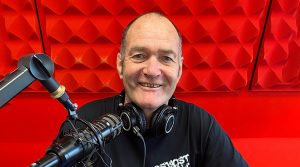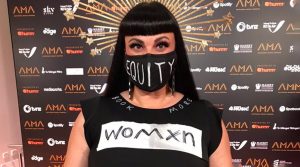Influencing Airplay Of Womxn On Kiwi Radio
Influencing Airplay Of Womxn On Kiwi Radio
Influencing airplay of womxn on Kiwi radio: Tami Neilson started it with a dress. At the 2021 Aotearoa Music Awards, she wore a dress pointing out some home truths about what it is like to be a female artist in this country.
The performers at the Covid-restricted awards ceremony that night were all males, which is what prompted her stylish protest. Her dress carried facts on how women artists were represented – ‘12% radio airplay’ and ‘19% festival line-ups’.
She deliberately chose the word ‘womxn’ in her visible protest.
“I used the term womxn as my intention was to include all women as well as non-binary and people who may not identify as women but who are non-male. I thought using ‘women’ would be excluding them, so chose to spell it with the intention of inclusivity,” she said.
That night, that dress made me stop and think. What if I was part of the problem?
As the host of the NZ On Air Kiwiana Show on The Most FM in Taranaki since 2009 I get to select my own content. Were my playlists equitable? I stopped to have a count. Through 2020, I found about 40% of the artists on my playlists were female, meaning, of course, males were coming in at 60%.
I set a goal of 50-50 each week, which I achieved easily and still am. There are many great Kiwi female artists, or as Tami put it, non-male artists.
This information made me listen to the radio with a new discerning ear. In keeping with the stats on Tami’s protest dress, I wasn’t surprised to hear very few females; in some hours I would hear none, and sometimes only one or two.
Also, not surprisingly, this was more prevalent when the radio host was male. This led to frustration and even some yelling at the radio. “Sexist!” I called out. “How can you play mainly men? How can you ignore half of the population of musicians and listeners?”
That anger moved on to questions. In reality, they were just doing what they’ve always done, and what they’ve always known. What they have learnt is from listening to the radio in the past. That is not meant to excuse their actions, but this is why we need to look at this learned behaviour and ask if we need change? And if so, how do we change?
The problem is a vicious cycle. If radio doesn’t play women artists and those that identify as not being male, then they will get less – less streams, less sales and less invites to festivals. These things are all linked, and in the end they mean less income for non-male artists.
Back to Tami Neilson, and why some radio stations, shows and hosts play mainly men, and where this behaviour has come from. Recently Tami shared a report about country music stations in the US, called They Won’t Play Lady-O on Country Radio. This examined back-to-back plays of female country artists. It took 9 hours and 16 minutes to hear back-to-back songs by women. In a 24-hour period, you would hear just three back-to-back tracks by women, which is below the 11% female total plays. Remember in NZ it is 12%.
The study went on to talk about Tomatogate after a radio consultant in 2015 said “Women in country music are not the lettuce in the salad but the tomatoes – they should be sprinkled on the playlist and not played back to back.” It was a ‘public admission of a statistical formula guiding radio practice around gender’. The report continued on to say: ‘Since the 1960s, programme directors have been telling people not to play women back to back.’
But what about back home in Aotearoa?
A recent Spinoff story about Brian FM received a Facebook comment suggesting there should be a Brianna FM, such was the dominance of male artists. The comment was ravaged and then disappeared.
The Amplify Aotearoa: NZ Music Community Diversity Survey undertaken in 2019 reported, ‘Gender emerged as a key factor when it came to opportunities, barriers, and experiences of discrimination.
More than two-thirds of women (70%) in the music community reported experiencing bias, disadvantage or discrimination based on their gender – seven times the rate of men (10%). Women reported being undervalued, overlooked, and patronised by their peers.’
This year, an Audioculture Classic NZ Album readers’ poll had only one female artist in the top 10. The website addressed this in their write-up of the survey. “This list is very white, and very male, which reflects historical power structures, and the lack of diversity in both mainstream and alternative music over many decades.”
When I interviewed Tami in 2022, she said, “I don’t think any change has ever been made without the discomfort of those who might be benefitting from the way things have always been.”
Asked what changes she would like to see in NZ music, she replied, “In an ideal world I’d love to see it be equal. I’d love to see women get the same opportunities, the same amount of airplay, the same festival slots. Just equal. I’d love to see it 50/50.”
So are things changing? How can we get better?
I’m proud to say that at The Most FM, 40% of new tracks added to the playlist are by female artists. I’m hopeful other stations around the Aotearoa are also doing the same. I also believe many would fall below the 12% average for the country.
In 1986, a petition was started to get NZ music played at 20% on radio. It succeeded in getting a radio convention together and a quota of 10% was set, though many radio stations weren’t necessarily happy about it. In 2000, that quota increased to 20% and NZ Music Month was born to support it.
Is this what we need, a quota of females played on the radio?
If so, how do we achieve it? If not, how will change happen? If you are a radio programmer or radio show host please start to speak up. Or act. I know a lot of readers, who probably haven’t got this far down, will be calling me woke and worse. But that is a badge I will wear with pride. Without action there will be no change.
Don’t give your daughter a guitar for her birthday, and don’t book her in for piano lessons – unless you’re OK with the idea that if she chose music as a career, her chances of radio airplay are low. Maybe non-existent. Especially, if we hear mainly men on the radio.
This is our moment to take action.
Warren Smart hosts the NZ On Air Kiwiana Show, and the NZ On Air Under The Mic on The Most FM in Taranaki.

